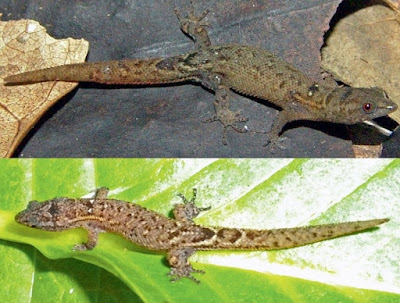 |
| Sphaerodactylus verdeluzicola Díaz-Lameiro, Villamil, Gamble, Pinto, Herrera-Martínez, ... et Daza, 2022 DOI: 10.1643/h2020123 |
Abstract
Advances in both morphological and molecular techniques have uncovered many lineages across the tree of life, and Neotropical vertebrates are no exception. Sphaerodactylus geckos (Sphaerodactylidae) are abundant and important components of the Neotropical herpetofauna, but few studies have thoroughly investigated them using a combination of morphology and modern molecular genetic methods. Here, we combine morphological and genetic data to describe a new species of Sphaerodactylus from the northwestern karst region of Puerto Rico. The new species is compared to other closely related and sympatric species of Sphaerodactylus. Morphological analysis shows that the combination of small body size (median SVL = 21.5 mm), lepidosis, skull morphology, and coloration of the head differentiates the new species from its closest relatives, including the related species, Sphaerodactylus klauberi. Comparing sequences of the mitochondrial 16S rRNA gene showed a genetic distance between S. klauberi and the new species of 5.1–5.6%, which is similar to genetic distances among other recognized gecko species. This is the first new species of Sphaerodactylus to be described from Puerto Rico in nearly a century, highlighting the continued need to evaluate and chronicle biological diversity even in well-studied regions.
 |
| Live coloration of Sphaerodactylus verdeluzicola. Above, a male specimen from Bosque Estatal de Río Abajo. Below, a female specimen from Rincon. |
Sphaerodactylus verdeluzicola, new species
English Common Name: Puerto Rican Karst Gecko
Spanish Common Name: Salamanquita de Monte y Mar
Etymology.— Specific epithet verdeluzicola is derived from the Spanish phrase ‘‘verde luz’’ with the suffix -cola to indicate that it is a Sphaerodactylus gecko dwelling in the place where the green light shines. The name is a tribute to the song Verde Luz, considered by some the second national anthem of Puerto Rico, by singer-songwriter Antonio Caba´n Vale ‘‘El Topo.’’ The song expresses a sentiment of longing for the homeland, while in the diaspora, and praises the natural wonders of Puerto Rico, such as the exquisite beaches, its karst terrain, and the emerald light emanating from the mountains and the sea—scenery that correlates with this gecko’s habitat. Furthermore, Antonio Caba´n Vale grew up in the town of Moca in northwestern Puerto Rico, which is within the current distribution of S. verdeluzicola.
Alondra M. Díaz-Lameiro, Catalina I. Villamil, Tony Gamble, Brendan J. Pinto, Alexandra Herrera-Martínez, Richard Thomas, Justin M. Bernstein, James E. Titus-McQuillan, Stuart V. Nielsen, Eliacim Agosto-Torres, Alberto R. Puente-Rolón, Fernando J. Bird-Picó, Taras K. Oleksyk, Juan Carlos Martínez-Cruzado and Juan D. Daza. 2022. A New Species of Sphaerodactylus (Gekkota: Sphaerodactylidae) from the Northwest Limestone Region of Puerto Rico. Ichthyology & Herpetology, 110(3); 449-465. DOI: 10.1643/h2020123
Las filogenias moleculares han elucidado múltiples linajes en el árbol de la vida, incluyendo varios vertebrados neotropicales. Las salamanquitas del género Sphaerodactylus (Sphaerodactylidae) son abundantes y forman una parte importante de la herpetofauna neotropical. Este género ha sido investigado recientemente utilizando métodos moleculares modernos. En este artículo se describe una nueva especie del género Sphaerodactylus, procedente de la región kárstica del noroeste de Puerto Rico. Los individuos de la nueva especie fueron comparados con especies afines y simpátricas. El análisis morfológico muestra que la combinación entre el tamaño corporal, escamación, morfología del cráneo y coloración cefálica, distinguen a la especie nueva de otras especies cercanas filogenéticamente, incluyendo su especie hermana Sphaerodactylus klauberi. Al comparar secuencias del gen mitocondrial 16S rRNA se observó una distancia genética de 5.1–5.6% entre la especie nueva y S. klauberi, dicha distancia es similar a la que existe entre otras especies descritas de salamaquitas. Ha pasado casi un siglo desde que la última especie de Sphaerodactylus de Puerto Rico fue descrita, ésto resalta la necesidad de seguir evaluando y catalogando la biodiversidad, inclusive en áreas que han sido investigadas a profundidad.




